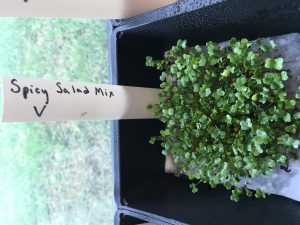 Microgreens, sprouts, and baby greens are simply greens harvested and consumed at an immature state. These tiny plants pack a punch – they have 4-40 times the nutrition of their full grown counterparts! Gourmet chefs love microgreens, but since the plants are tender and spoil quickly, they are expensive and not usually found in grocery stores. Growing small amounts of microgreens indoors at home is relatively easy if you follow these simple steps:
Microgreens, sprouts, and baby greens are simply greens harvested and consumed at an immature state. These tiny plants pack a punch – they have 4-40 times the nutrition of their full grown counterparts! Gourmet chefs love microgreens, but since the plants are tender and spoil quickly, they are expensive and not usually found in grocery stores. Growing small amounts of microgreens indoors at home is relatively easy if you follow these simple steps:- Use a shallow container. Take-out containers, pie plates, and salad containers all make great microgreen gardens.
- Have the right mix. Microgreens can be grown in a standard, sterile, loose, soilless germinating media. Other mixes that have shown success include: peat, vermiculite, perlite, and coconut fiber. Partially filling a tray with media to a depth of ½ inch to 1-2 inches is sufficient.
- Seeding. Select crops that have similar growth rates so the entire container can be harvested at once. The time from seeding to harvest varies greatly from crop to crop. Sprinkle the seeds thickly over the growing medium and then mist using a water bottle.
- Cover the seeds. This will help promote seed germination and keep the seeds moist. Check on your sprouts daily and remove the cover once you see the seeds sprouting.
- Sunlight. Place the container in a sunny window or porch where it will get at least four hours of sun. Protect the seedlings from direct afternoon sun in the summer.
- Water. Mist your greens daily, keeping the soil or mat moist, but not soaking wet.
- Harvest. Microgreens will be ready to harvest between 7 and21 days depending on the crop. Cut the stems with scissors. Harvested microgreens are highly perishable and should be washed and cooled as quickly as possible.
For more information, please visit “Microgreens: A New Specialty Crop.”
By Amy Vu, Extension Agent, Residential Horticulture
 0
0
